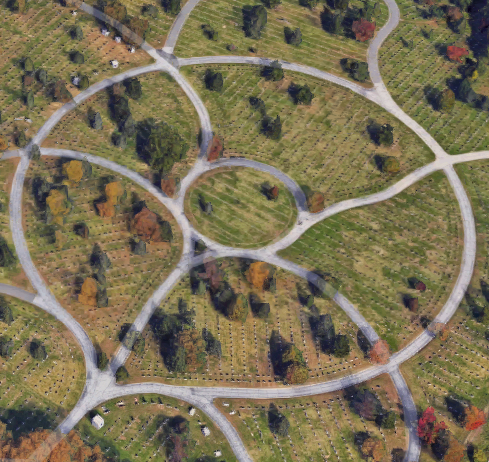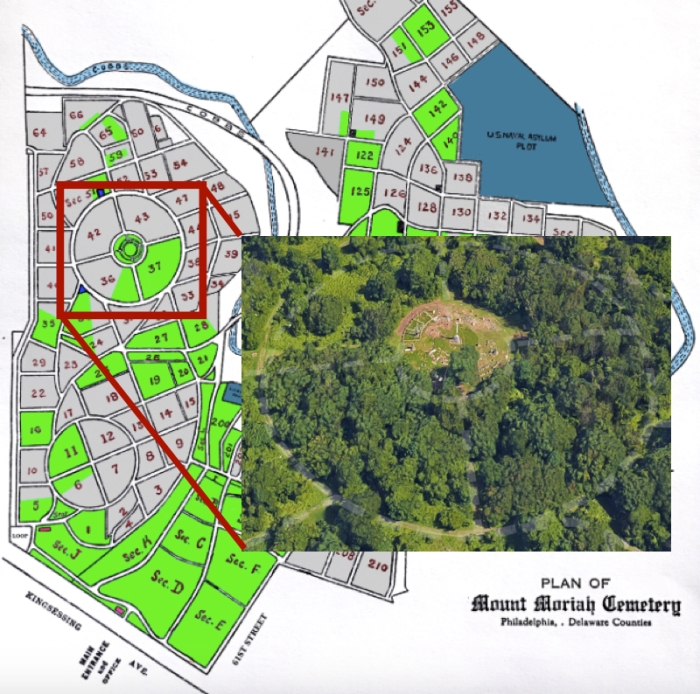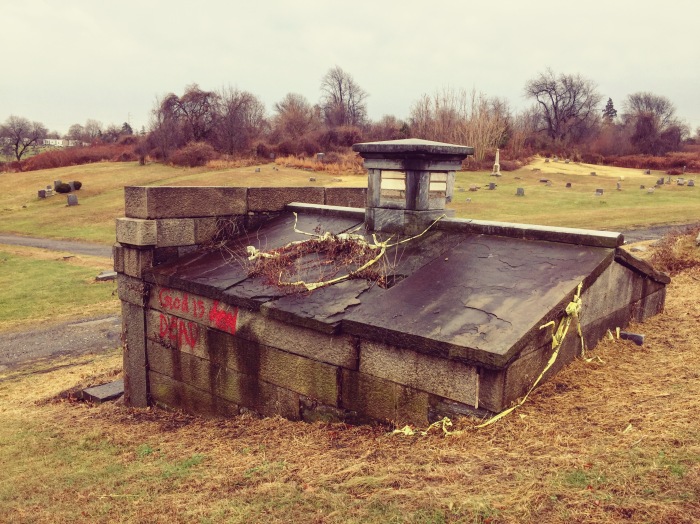An elegant sprawl of manicured land is probably what comes to mind when you think of a cemetery. But this picturesque model is relatively new in the Western world and has been difficult for some cemetery associations to preserve. Such is the case with Mount Moriah in Philadelphia. Before the 1700s overcrowded churchyards housed a majority of a city’s dead as I explored in another post. Thankfully, city planning took over for sectarian gravesites after they became an issue of public concern. The first landscaped cemetery opened in France in 1804. Greenspaces built in this romantic style are the marbled terraces that taphophiles know and love today.

Sometimes called rural cemeteries because they were strategically placed outside city limits, the first manifestation of American garden cemeteries was established in 1831 at Mount Auburn near Boston. This trend quickly took hold and by the 1850s nearly 30 garden cemeteries were built across New England and the MidWest. From their earliest development garden cemeteries were used as public parks for recreation purposes.

Unfortunately, civic interest has dwindled throughout the twentieth century and some cemeteries have fallen into disrepair. The number of cremations also increased meaning that families no longer needed a physical site to visit their dead. Moreover, maintaining a huge ornamental garden was an exceptional cost that some growing municipalities simply couldn’t afford. Mount Moriah fits into the latter category.

Healthy garden cemeteries maintain clean geometric shapes that balance natural elements like the satellite view of Philadelphia’s Woodlands shown above. Mount Moriah on the other hand has become astonishingly overgrown. For visual reference I contrasted the original cemetery plans below with an aerial cutout outlined in red as it exists today. Where there should be rows of neat headstones are now mostly trees.


Mount Moriah cemetery was complete in 1855 in southwest Philadelphia. It joined other famous garden cemeteries like Laurel Hill and The Woodlands. At one point Mount Moriah outpaced them all, consuming over 200 acres of land making it the largest in the state.

It is unclear when the cemetery began to visibly decline but has suffered from neglect and mismanagement throughout the twentieth century. There are however two military plots located here that are still well-maintained by the Department of Veterans Affairs.

The cemetery has no clear ownership after its last known member of the cemetery association died in 2004. Since then it has been gridlocked in a unique battle because it spans two county lines.

Fortunately for those laid to rest and families who wish to visit the deceased, a nonprofit group called Friends of Mount Moriah organizes regular cleanups and fundraisers to secure the yearly $500,000 operating fee. Even with community support there is much to be done in the way of clearing extensive brush.

Several famous political figures are buried here including past mayors and state representatives. Betsy Ross, craftswoman of the first American flag was interred with her husband until they were both relocated to Christ Church in the mid-1970s.

Mount Moriah cemetery was known in the community for being an affordable option. While other facilities charged upwards of $5,000, Mount Moriah offered similar landscapes for less than half that – an option considerate of its surrounding lower-income residents.

Business activity officially ceased as of 2011. Even if families currently hold deeds to plots there is no operator who coordinates and consents to burials on the property, which means that no new interments can take place.

The city of Philadelphia has no oversight of the land and cannot offer funds for its upkeep. There are no shareholders to push for election of new board members. Mount Moriah’s complicated status may be the only predicament of its kind. With no legal precedent it is unclear when and if duly authorized individuals can rectify the cemetery’s insufficient perpetuity fund.

Lending to Mount Moriah’s importance as a cultural hub is the provision of many unique arrangements. Several Muslim burials have taken place here while other regional sites historically shut them out. Mount Moriah features rare communal burials allowing for up to three family members in the same plot which helped reduce costs.

To see such a beautiful place in a state of disrepair with no certain future is heartbreaking to say the least. The feeling of woe is further compounded when considering the geographic location. While places like Laurel Hill are situated in more affluent parts of town you have to consider that Mount Moriah’s neglect is part of the larger issue of urban decay plaguing Philadelphia’s lower West side.

The Friends of Mount Moriah have been operating since 2011 entirely on public support. As their mission statement notes, the cemetery is an important resource for several racial, religious, and socioeconomic stakeholders. Widespread community involvement to revive the cemetery’s rich history is a cause to celebrate. If you do not live in Philadelphia or are otherwise unable to attend restoration events you can assist by purchasing a t-shirt or donating in kind. With continued engagement from cemetery lovers of all walks of life the history of garden cemeteries like Mount Moriah will continue to thrive.
Interesting and thought-provoking post. One of my Masters papers was on garden cemeteries in Toronto, and since that time I’ve always been interested in these (and many other kinds of) cemeteries. Mount Moriah shows that the neglect that once occurred with big cemeteries in other places, like most the of “Magnificent Seven” in London, is still happening today. And yet with baby boomers entering their twilight years in the coming decades, I’m sure the need for burial spaces will only increase – will that save these older cemeteries, or will be they completely abandoned for some other form of remembrance?
LikeLike